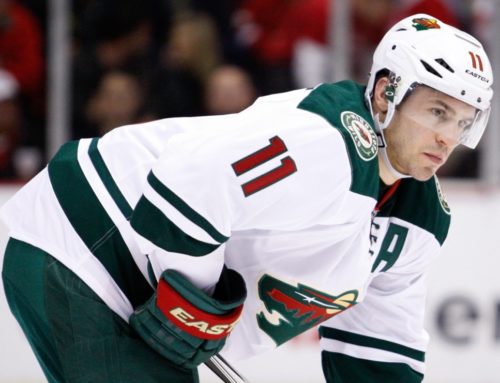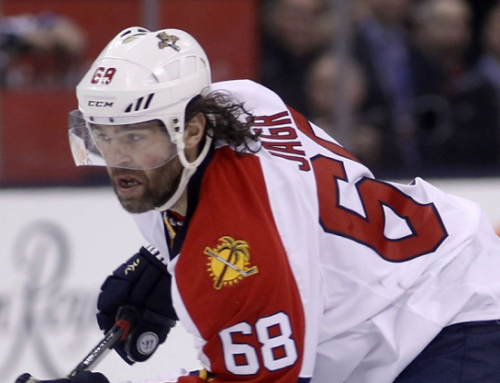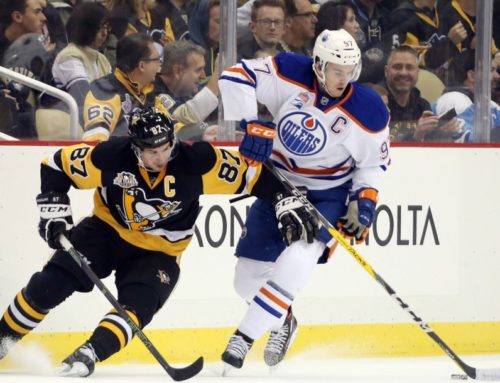The Contrarian: The Quick and the Presumptuous
Demetri Fragopoulos
2016-10-16

Demetrios Fragopoulos looks at the impact the World Cup of Hockey has had on early-season production and injuries in this week's edition of The Contrarian …
We have seen some outstanding performances from only a few days of the season. As Wayne Scanlan, of the Ottawa Citizen, points out “Brad Marchand had a five-point night for the Boston Bruins. Auston Matthews popped four goals for the Maple Leafs against Ottawa (perhaps you’ve heard).”
He also identifies the other unpleasant side, “Goaltenders Jonathan Quick, Matt Murphy and Carey Price are all either injured or sick.” You can add many more names but the biggest would be Sidney Crosby and his latest concussion.
Scanlan quickly concludes, “The immediate impression: players from the WCH2016 are either wrecking the stats sheets or getting wrecked themselves. A long list of players who took part in the tournament, and entered the NHL season in competitive game form, sit atop the scoring categories” and “It’s almost unfair the advantage WCH2016 players have in week one.”
It sure seems like it but do the participants of the WCOH have an unfair advantage?
Let us start with the goalies. There were 24 involved in the WCOH, and of those, 14 have played in NHL action for a total of 15 games played.
The results are six wins, eight losses and 47 goals against, which is a little over three goals per game.
Sure, Matt Murray has a broken hand, and Carey Price is sick with the flu, but would the results be much different? Frederik Andersen and Robin Lehner, who should have played in the WCOH but could not due to injury, started this year with a combined zero wins, two losses and nine goals against in two games.
Then there is Ondej Pavelec who saw himself being waived before the season started. From WCOH to AHL. Salary and cap numbers contributed to that situation, but you would think that a person good enough to be listed on a WCOH roster would be valuable enough to begin the season in the NHL.
The 14 non-WCOH goalies have a record of 10 wins, eight losses and 54 goals against in 18 games. That is exactly three goals a game.
Do you see the advantage because I do not? I also do not see the disadvantage from the injuries either.
Yes, Price and Murray are big losses to begin with, add Jonathan Quick and it appears drastic, but remember that Price is not playing because of a flu. Was he to be diagnosed with mononucleosis, like Curtis Lazar, that would be a different story. He will return in due course.
So, let us call the goaltenders a wash. Neither a huge advantage or disadvantage. So Scanlan must then be focusing on the skaters. That is where we go next.
Concussion (Crosby), broken foot (Marian Gaborik), groin (Ales Hemsky), ankle (Jack Eichel), lower-body injury (Patrice Bergeron and Dmitry Kulikov) and general injury (Jakub Nakladal) totals seven forwards that were part of the WCOH and have not played yet this season. Seven out of a total of 160 skaters.
I do not like seeing any player get hurt, but this does not seem to be as extreme as Scanlan suggests “The flip side of the conditioning/competition advantage of tournament players is that so many of them are either hurt or sick.”
To this date, all the WCOH skaters have accumulated 46 goals – six being game winners, 111 points, 83 penalty minutes and a plus/minus rating of +22 in 146 games.
There were 13 players that were named to a WCOH team but could not play in the tournament but only four remained out of action. Ryan Callahan and Niklas Kronwall were injured well before the tournament, Radko Gudas earned himself a suspension and Rickard Rakell was holding out until a few days ago. The players that missed the WCOH but not the NHL season have so far earned, two goals, eight points, six penalty minutes and a plus/minus rating of -6 in 13 games.
There seems to be an advantage.
Let us continue our investigation by looking at the top 10 players that were and were non-participants in the WCOH.
|
Top 10 Players |
Games Played |
Goals |
Points |
+/- |
Penalty Minutes |
Game Winning Goals |
|
Non-WCOH |
15 |
13 |
27 |
+13 |
6 |
2 |
|
WCOH |
14 |
19 |
38 |
+23 |
6 |
2 |
|
Difference |
-1 |
+6 |
+11 |
+10
📢 advertisement:
|
0 |
0 |
While this looks to validate Scanlan’s thoughts on the matter put it into context. The top 10 of the best-of-the-best have only out produced the top 10 of the rest by six goals, 11 points and a plus/minus rating of +10.
According to Scanlan, there should be a vast difference.
I will demonstrate the same statistical breakdowns but this time using the top 40 players.
|
Top 40 Players |
Games Played |
Goals |
Points |
+/- |
Penalty Minutes |
Game Winning Goals |
|
Non-WCOH |
54 |
32 |
83 |
+33 |
21 |
7 |
|
WCOH |
51 |
33 |
86 |
+35 |
14 |
6 |
|
Difference |
-3 |
+1 |
+3 |
+2 |
-7 |
-1 |
The WCOH group have three games in hand over the rest and it will bump up their totals but even in doing so there is no huge gap.
This would be normal and even expected of any season would it not? The best-of-the-best should be out distancing themselves from the rest.
The performances of Marchand, Matthews, David Pastrnak and Thomas Vanek (which Scanlan refers to further into his piece) are great. No questions about them.
The counter is the steady performances of Paul Stastny, Jordan Eberle, Kevin Shattenkirk, Alexander Steen, Kris Russel, Ryan Johansen and even Nail Yakupov.
Even at that, only three days of the NHL schedule have been completed. Some clubs have not had their first match yet.
It is presumptuous to conclude after so few games that a huge advantage is with the players from the WCOH and also that they are more susceptible to injury.
Maybe after a month of action is in the books the stats will bear fruit for Scanlan, but for now I see nothing out of the ordinary.
The best are the best, the rest will try their best and an unlucky subset of each will need some bed rest.
One Comment
Leave A Comment
You must be logged in to post a comment.





 EDM
EDM DAL
DAL S.J
S.J MTL
MTL TOR
TOR FLA
FLA CAR
CAR UTA
UTA NYI
NYI CGY
CGY L.A
L.A

who’s Matt Murphy?